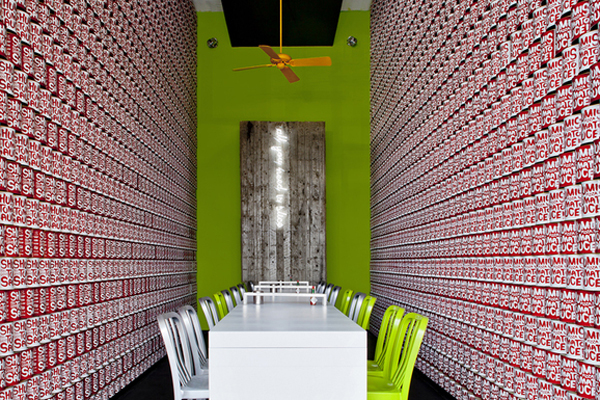Fai Au, founder of O Studio Architects, talks about a project modelled after a seed and the firm’s approach to design.
February 28th, 2012
The Church of Seed, which sits perched atop China’s sacred mountain, Mount Luofu, takes its inspiration from a seed – an oft-mentioned metaphorical element in the Gospel stories.

Church of Seed is the first western religious building on Mount Luofu, one of 7 famous sacred Taoist mountains in China.
Its main structure is made from in-situ concrete with bamboo formwork and is defined by 3 curved walls that together form the shape of a seed. A stepping roof terrace allows diffused northern daylight to penetrate the interior while providing a dramatic ceiling height increment of 3 to 12 metres from the main entrance to the place of worship. Above, visitors can make their way up the stepping roof to an observation deck that affords wide-ranging views of the mountain landscape.

The curved walls split to form 3 openings in the structure.

An observation deck on the roof from which to take in the view.
The abstract form and space of the church is conveyed through the play of light, shadow, material and texture. And as is likely the intention, the severe, bare-boned simplicity evokes a quiet sense of awe – paradoxically also keeping it close to the surrounding village life.
There has been some debate over its similarities to Le Corbusier’s Notre Dame du Haut in Ronchamp. But before you decide, read on for our interview with the studio’s founder and principal, Fai Au.
How did the idea of using the concept of a seed as the project’s starting point come about?
The idea of ‘seed’ came along in the series of discussions between the client and us. Seed is a metaphorical element [that] frequently appears in the Gospel stories. Eventually it became our design inspiration.

The concrete walls are made less stark with bamboo formwork.
What were come of the most important considerations for you with this project?
One of the most important considerations was to use bamboo formworks for the concrete structure. This is an economically sound construction method. The bamboo texture left on the concrete wall surfaces gives great visual excitement.

The chairs are made from bamboo by local farmers.
What sort of experience is this building designed to give the visitor?
This building provides not only [a] worship and meditation space for Christians, but also [a] gathering place for the local village people. The design demonstrates a great play of light and shadow, which makes the place sacred yet exciting.

The cross-shaped opening on the southeast facing wall introduces morning sun into the interior.
It appears that sensitivity to culture and place informs your work, both in Church of Seed as well as other projects.
Sensitivity to culture and place is essential for every project we have done. We do not favour a signature style or fixed architectural language for projects. Through our design, we intend to respond to the local culture and site characteristics of various projects.
Your website states that the studio intends to pursue “form-making and sustainable design” in a “primitive and fundamental” way. Can you give an example from your work?
Fanling Class Car Museum is a great example. In this project, we use [a] series of circular zones to preserve all of the existing trees on site. This is a straightforward approach that does not only respects the natural environment, but also transforms the existing environment into an exciting background for the car exhibition.
What are you working on at the moment?
We are currently working on several hotels, mixed-use master planning projects and luxurious houses in Hong Kong and Mainland China.
O Studio Architects
ostudioarchitects.com
A searchable and comprehensive guide for specifying leading products and their suppliers
Keep up to date with the latest and greatest from our industry BFF's!

Within the intimate confines of compact living, where space is at a premium, efficiency is critical and dining out often trumps home cooking, Gaggenau’s 400 Series Culinary Drawer proves that limited space can, in fact, unlock unlimited culinary possibilities.

Elevate any space with statement lighting to illuminate and inspire.

In this candid interview, the culinary mastermind behind Singapore’s Nouri and Appetite talks about food as an act of human connection that transcends borders and accolades, the crucial role of technology in preserving its unifying power, and finding a kindred spirit in Gaggenau’s reverence for tradition and relentless pursuit of innovation.

To honour Chef James Won’s appointment as Gaggenau’s first Malaysian Culinary Partner, we asked the gastronomic luminaire about parallels between Gaggenau’s ethos and his own practice, his multidimensional vision of Modern Malaysian – and how his early experiences of KFC’s accessible, bold flavours influenced his concept of fine dining.

Entries in the 2013 Restaurant and Bar Design Awards (RABDA) will close on April 14
As of July 1st 2008, the Royal Australian Institute of Architects (RAIA) dropped the Royal and are now to be referred to as the Australian Institute of Architects (AIA). Visit the website
The internet never sleeps! Here's the stuff you might have missed

Architectus has completed the Health and Community Centre of Excellence for Kangan Institute, an education facility featuring TAFE and more.

Rebecca Wright, Principal at Plus Architecture, weighs in on the innovative nine-day fortnight work model, shedding light on its impact on work-life balance and productivity.

Italian commercial furniture brand Arper – a long-time partner of Stylecraft – has unveiled new pieces that redefine innovation and environmental responsibility.

To honour Chef James Won’s appointment as Gaggenau’s first Malaysian Culinary Partner, we asked the gastronomic luminaire about parallels between Gaggenau’s ethos and his own practice, his multidimensional vision of Modern Malaysian – and how his early experiences of KFC’s accessible, bold flavours influenced his concept of fine dining.